How to save money on heating a pool
Swimming in a warm pool is a wonderful feeling, and while we hear from many pool owners in the cooler states & provinces that they really enjoy the experience of a warm swim from late spring or early summer through to autumn, the cost of heating their pool can be a major downer, even with a highly efficient system like a Heat Pump Pool Heater (HPPH). One of the things we’re asked a lot at EcoHome is “How can I reduce the cost of heating my swimming pool?”
There are clearly two factors here – just like when heating a home. On one hand we need to consider how to reduce the cost of the energy used to heat the pool, on the other hand we need to consider how to reduce the amount of heat a pool loses and therefore needs. If it loses less heat in the first place, a pool will cost less to keep warm because it needs less energy to maintain a constant and comfortable temperature after the initial heat-up period. A Passive solar home design is always the cheapest to heat, environmentally speaking.
Each pool environment is different, so while the savings for each tip are universal in the scheme of things, they are not all universally applicable to a particular pool. Here are ten tips that will help save energy and money on pool heating costs and even if some will save more than others, each tip on their own will save on energy use to some percent – And as they say, there’s no such thing as a small economy!
We found a large choice of money saving solar pool heaters online here and we have a guide on saving energy for swimming pools and hot tub operation here.
We’re going to start by tips to conserve energy over the years, right when planning a pool...
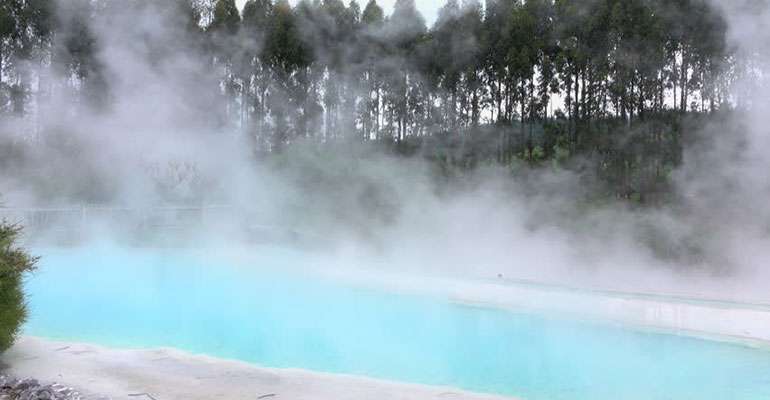
Tips to reduce energy use by good pool design
1) Pool Insulation to reduce heat loss:
When planning a pool, think insulation. All pool designs, including a Natural pool or swimming pond, can benefit by incorporating some rigid panel insulation under and around the structure of a pool to save energy and costs in the long run. Regardless of where you are in the USA or Canada the ambient temperature of the ground is pretty constant, and it’s usually colder than the ideal temperature for enjoying a swim in the pool, so putting some insulation outside the thermal mass of the water retaining structure is a great first step in reducing the costs associated with heating a pool over the long term.
2) Optimize Pool Mechanical Systems - (For the Vets out there, the 7P's) :
A well planned pool pump and filtration system helps energy efficiency & saves money. Plan from the beginning for extra valves to be fitted in pipe runs so that additional pool heating systems like a heat pump or solar panels can be easily retrofitted or drained down for winterizing in the future. A little more thought at the planning and installation phase always saves money in the long-term – and let’s you fit the most efficient heating systems to your pool in the years ahead. Instead of the classic Army acronym 7P's, perhaps we should remember Proper Planning Provides the Possibility of Peak Pool Performance?
3) Pool location in the yard:
Siting the pool needs careful thought for free heating! For passive solar heat gain it needs ideally to be located to get maximum sun - this is optimized "Insolation", not to be confused with "Insulation!" At the same time it’s also ideal to have a pool in an area shielded from the wind, as wind on the surface of a pool creates ripples or small waves. Heat loss through evaporation is an interaction of water temperature, air temperature, humidity, and surface area of the pool. A flat, tranquil swimming pool will have a water surface area equal to the physical dimensions of the pool. Ripples and waves on the pool increase the surface area of the water exposing more of the surface to the colder air on all but the hottest days, but also accelerate the losses from evaporation. Locating a swimming pool in an area that gets both sun and which is shielded from the wind is a huge win/win and will be a great help in increasing solar gain while reducing heating requirements and the losses associated leading to higher energy use and costs.
4) Pool color effects the amount of solar gain - so choose color appropriately:
Black gets hot where white stays cool. Ever noticed that the color of your car effects how hot it gets when parked up in summer under a blazingly blue sky? It's exactly the same with swimming pools... If located in a year round hot climate zone like New Mexico, Texas, Southern California or Florida (or any other southern US state) then choosing the pool color shouldn't just be about aesthetics. Neither should choosing a darker colored pool be ignored if in Quebec, Ontario, BC, Montana, New York or Illinois and serious about enjoying a backyard pool for as much of the year as possible without the pool heating costing the Earth. Literally.
Reduced pool heating costs = better savings
5) Use the Cheapest Source of Heat:
Solar should always be the primary heat source for a pool which will be a combination of good location in the yard to maximize sun exposure on the pool itself, combined with the pool color (tip 3) and by installing some hydronic solar panels. Solar heating is essentially free (there are some small increases in electricity for the costs of pumping water through larger solar panels, but it is minimal as this links to the pool filtration system anyhow if planned and built right.) The downside of solar, especially in more northern areas, is that it rarely meets the needs for a full season of heating demand or it fails, due to poor design, to provide heat fast enough or when the sun isn’t shining due to time of day or cloud cover for successive days. But when solar is a possibility and you have the initial budget to purchase a decent solar system with a Heat Pump Pool Heater backup, the combination of the two systems will be the best, most economical system available.
6) Choose the best time of Day for Heating to Run:
Setting the timer to run HPPH around noon helps to lower energy costs. On systems with a Heat Pump Pool Heater (HPPH) for 100% of their heating requirement, the time of day that you run your HPPH is an important consideration as heat pumps get their heat from the air. Logically then the best time to run a HPPH is when the air temperature is at its warmest during the day. This is most easily accommodated by setting the controls for your filtration system to operate during the warmest time of the day as well - as a Heat Pump Pool Heater (HPPH) will only operate when it has water flow. As long as your filtration is running at the warmest time of the day, your HPPH will operate at its optimum Coefficient of Performance (COP) or efficiency which is calculated by dividing the measure of energy output divided by energy input. Pool Heat Pump heaters generally have a COP between 3.0 to 7.0. It's probably possible to find smart control systems for swimming pools, and if not, we're sure it will be shortly.
7) Speaking of COP, choose a high efficiency HPPH & size it correctly:
The COP is the efficiency rating of the HPPH. Heat pump pool heaters are really energy efficient and the energy efficiency of a heat pump pool heater is measured by the coefficient of performance (COP). The higher the COP for the pool heater, the more energy efficient it is. Typically, COP is measured by testing a heat pump pool heater with an outdoor temperature of 80 degrees. COPs usually range from 3.0 to 7.0, which equates to a multiplying factor of around 500%. This means that for every unit of electricity it takes to run a compressor, you get 3-7 units of heat from it. This is why fitting the right size of heat pump for your pool is of primary importance for optimum efficiency and to minimize energy costs. Sizing a heat pump pool heater involves many different factors so whenever you’re sizing a heat pump, the surface area of the pool is taken into consideration. Basically, a heater is sized based on the surface area of the pool and the difference between the pool and the average air temperatures.
The variables for pool heating:
- Wind exposure factors
- Humidity levels for the area
- The Cooling factor in areas of lower night-time temperatures
Heat pump pool heaters are rated by Btu output and horsepower (hp). Standard sizes include 3.5 hp/75,000 Btu, 5 hp/100,000 Btu, and 6 hp/125,000 Btu. To calculate heater size for an outdoor swimming pool, follow these steps to give an approximate required rating:
- Decide the preferred swimming pool temperature.
- Define the average outside temperature for the coldest month for pool use.
- Subtract the average temperature for the coldest month from the preferred pool temperature to give the temperature rise needed.
- Calculate the surface area of the pool in square feet.
Apply this formula to calculate the Btu/hour output rating of the pool heater needed:
Pool Area x Temperature Rise x 12 = Btu/h
This formula is based on 1º to 1-1/4ºF temperature rise per hour and a 3-1/2 mile per hour average wind at the pool surface. For a 1-1/2ºF rise multiply by 1.5. For a 2ºF rise multiply by 2.0.
Conclusion? It means it’s best to buy the highest COP-rated unit in your budget while ensuring the model selected has the heating capacity, or BTUh, to meet the calculated heating demand needed. Find out how hot water heat pumps work and why you should get one here.
8) Choosing the best solar heating panels for swimming pools
Solar pool collectors vary in efficiency and cost - the trick is finding the best compromise that covers your needs. Solar panels are made out of different materials and the type you'll need depends on your climate and how you intend to use the collector. If you'll only be using your pool when temperatures are above freezing, then you'll probably only need an unglazed collector system. Unglazed collectors don't include a glass covering (glazing). They are generally made of heavy-duty rubber or plastic treated with an ultraviolet (UV) light inhibitor to extend the life of the panels. Because of their inexpensive parts and simple design, unglazed collectors are usually less expensive than glazed collectors. These unglazed systems can even work for indoor pools in cold climates if the system is designed to drain back to the pool when not in use. Even if you have to shut the system down during cold weather, unglazed collectors may be more cost effective than installing a more expensive glazed collector system.
Example of how a solar collector for pool heating works:
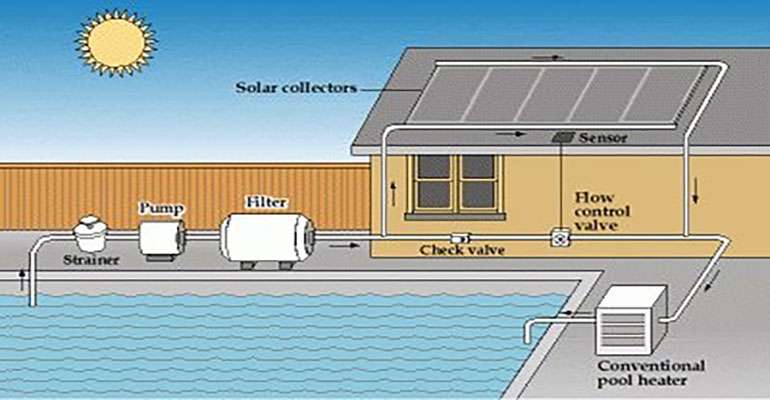
Glazed collector systems are generally made of copper tubing on an aluminum plate with an iron-tempered glass covering, which increases their cost. In colder weather, glazed collector systems—with heat exchangers and transfer fluids—capture solar heat more efficiently than unglazed systems.
Therefore, they can be used year-round in many climates. Glazed collectors also can be used to heat domestic hot water year-round though both glazed and unglazed collector systems should include freeze protection if they'll be used in colder conditions. For more detailed instructions on solar swimming pool heaters, see the US Government site here.
9) Reduce the thermostat setting a few degrees & save money:
Few people realize what a big percentage saving each degree of reduction in temperature makes. One important point to remember when looking to run a swimming pool in a more eco-friendly way and economize on pool heating is the pool temperature thermostat setting. Obvious really yet often overlooked, the warmer you heat your pool the more it costs to keep it to a higher operating temperature.
Each degree rise in temperature equates to an approximate 15-18% increase in energy use and operation cost. So, while an 88°F pool is lovely & warm, it will cost a lot more to heat than a pool set to warm to 85°F. Everybody has their own “thermostat” and comfort level when it comes to pool temperatures - just look at home temperatures! Likewise with a pool’s water temperature; warmer is nice but costs more - simple thermodynamics and economic math.
10) Reducing pool evaporation saves energy & money:
Evaporation is by far the largest source of energy loss from a pool. Evaporating water requires tremendous amounts of energy. It only takes 1 Btu (British thermal unit) to raise 1 pound of water 1 degree, but each pound of 80ºF water that evaporates takes a whopping 1,048 Btu of heat out of the pool.
This diagram shows outdoor pool energy loss percentages:
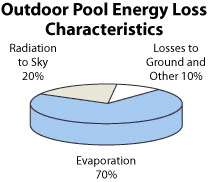
In any backyard pool across the USA in a climate zone with 4 seasons, there's a 70% energy loss from evaporation, 20% from radiation to sky, and 10% to ground and other. Heat loss of any pool, heated by any means, is primarily driven by evaporation from the surface of the pool. Upwards of 70% of heat loss is through evaporation. Controlling the evaporative loss is therefore a key factor in reducing heating cost and there are several methods of achieving these savings, some more Eco-friendly than others.
One method is to install a solid roller blanket type pool cover. The most permanent (and expensive) option is also considered a “safety” blanket as well as a method of heat retention/ evaporation prevention. It is typified by its automated roller shutter type operation to roll the heavy-duty vinyl blanket out over the surface of the pool. They completely cover the surface of the pool and by their design and construction will bear the weight of a child who inadvertently enters the pool area making a very safe environment for children so long as it’s closed before they get near it. The added value for these pool covers is that they also reduce evaporation to a near zero rate. Excellent for safety and efficiency, but maybe not so good for the environment due to their extensive use of vinyl as a construction material. (see here)
How good an eco-friendly option are bubble type roll up pool covers?
Another type of pool cover or blanket which is much more affordable, but with no safety value, is what is called a floating blanket. This blanket is simply a thin vinyl, polyethylene or polypropylene sheet manufactured with tiny air bubbles… think bubble wrap on a large scale. This blanket does an excellent job of heat retention through the prevention of evaporation, and if they are colored and stabilized against UV appropriately, they can accelerate solar gain of a lighter colored pool. However, they are not safety blankets and actually carry a safety risk should a child enter the pool area with a floating blanket in place. The blanket can become an entrapment hazard due to its free-floating nature and the tendency to wrap around an individual who ventures onto it (as Lethal Weapon demonstrated in 1987).
Many who have considered or used both of the above described blankets also consider them to be unsightly, difficult and/or expensive to use - and as we said, surrounding ourselves with vinyl is not a great choice of material so polyethylene may be a better choice (see here). The last type of blanket available on the market is the Liquid blanket, so we should look at that.
What Are Liquid Solar Covers for Pools?
A liquid solar cover is a microscopically thin layer of alcohol that sits on top of the water of a pool. This layer reduces water evaporation which is a major cause of water heat loss and there are liquid solar covers which have been FDA and EPA approved to use in swimming pools. Some have also been approved by the NCAA (The National Collegiate Athletic Association). According to certain patents, it’s is a combination of:
"an aliphatic alcohol component having from 12 to 24 carbon atoms per molecule combined with calcium hydroxide"
The calcium hydroxide appears to be just a carrier and dispersing agent, so chemistry aside, the operative phrase is “one molecule thick.” It uses such a small amount of liquid that you shouldn't feel it, nor is there any case we're aware of it causing physical harm to swimmers.
How to use liquid solar covers
- Purchase enough liquid solar cover to last at least a couple of months as this will save postage costs. How much you need depends on the size of your pool. Expect to spend anywhere from $10 to $20 a month and maybe a little more if you have a large pool.
- Schedule adding product. Adding product is best done on a regular monthly schedule when you plan on adding your liquid solar cover. Once you set this schedule, stick to it. In order for it to be effective, it needs to be added on a regular basis.
- Simply pour the liquid blanket in the right quantity into your pool on your set day. The liquid solar cover will float to the top of the water and disperse across your pool binding together to form the blanket.
That’s all there is to it, apparently it couldn’t be easier to use a liquid solar pool cover!
While this solar blanket poses no safety risks, is easy to use, will not have a negative effect on the pool filtration system and is inexpensive, it would also seem to carry the lowest level of effectiveness. These liquid solar blanket’s performance are affected by wind speed at the surface of the pool as well as water features that break the surface of the pool creating pool surface agitation. While it is the least effective of the three types of blankets, we have to say it is still better than doing nothing to stop pool evaporation.
So, there you have the EcoHome Top Ten Tips for saving energy & money on Swimming Pool Heating - from the EcoHome Green Building Guides. If You've any other helpful comments, ideas or questions, please post them below.

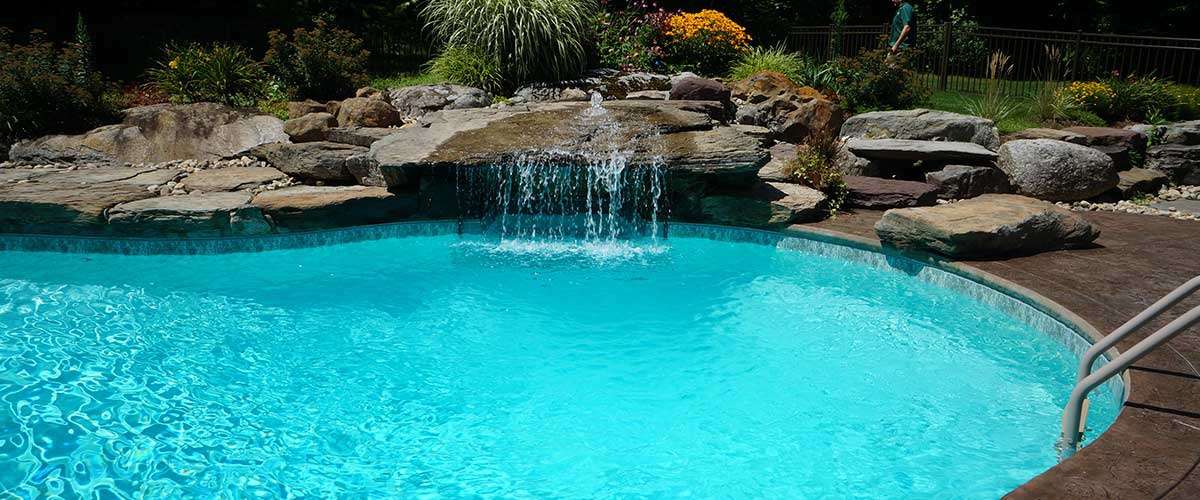














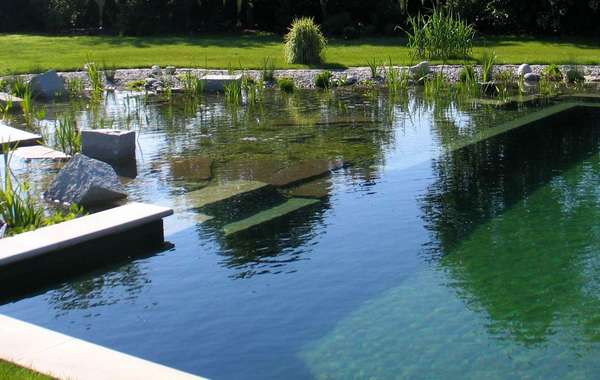
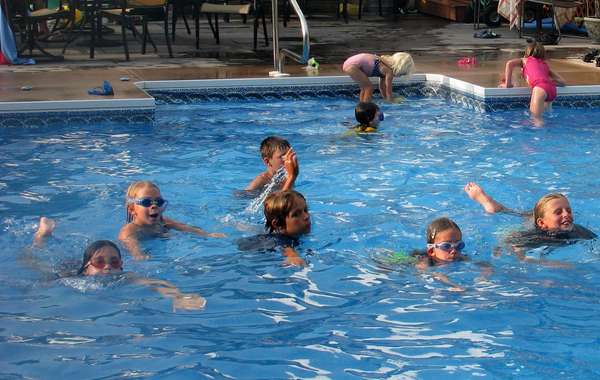
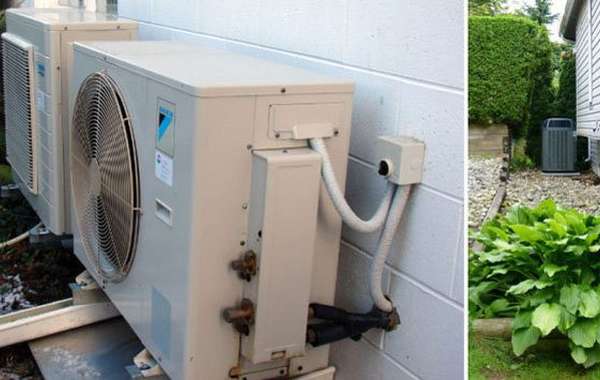
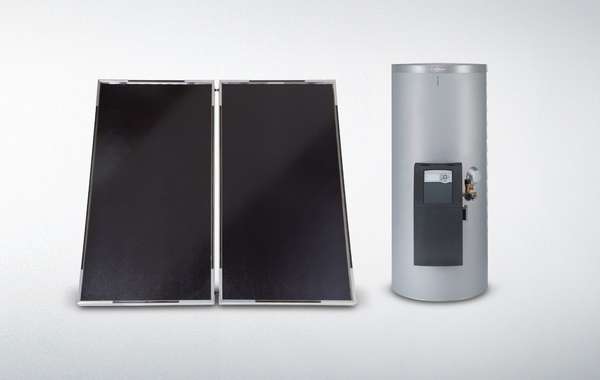
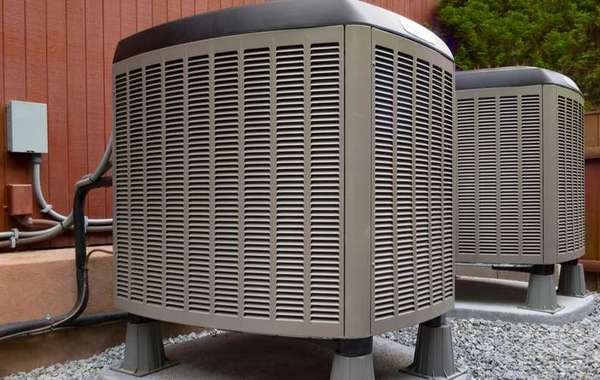
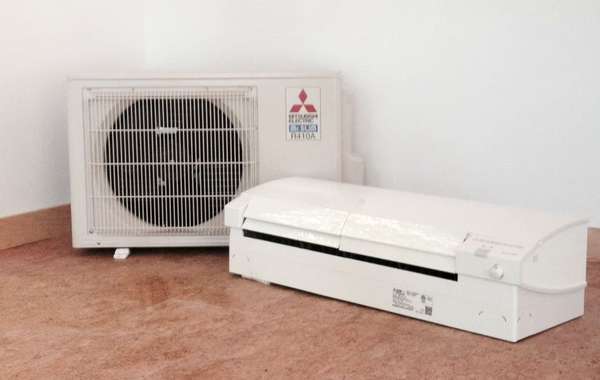
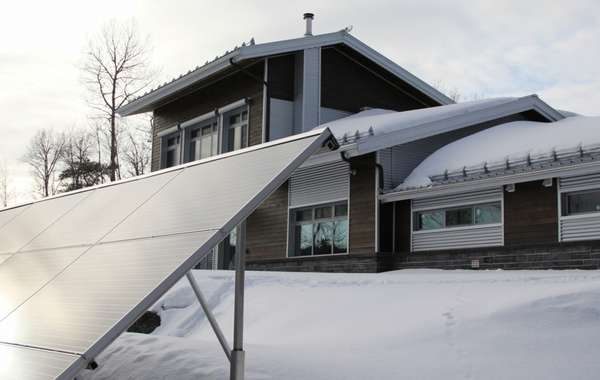
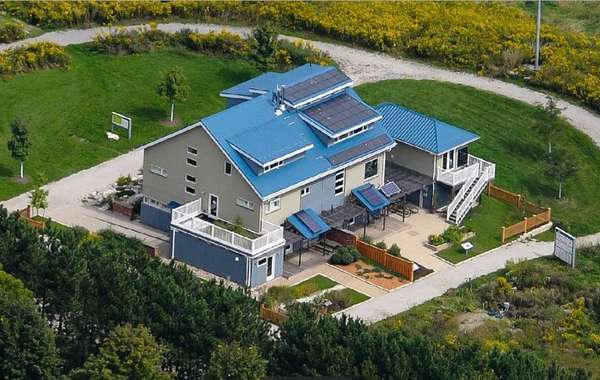
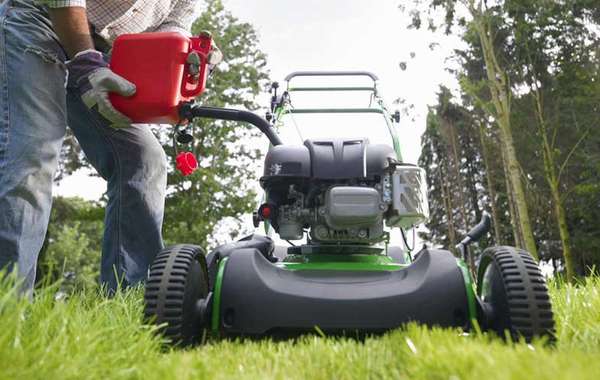
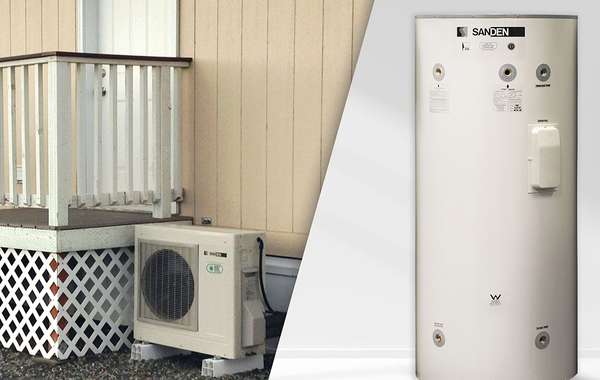
I have seen liquid solar covers in the shape of a floating fish. Are they as effective as from the bottle?